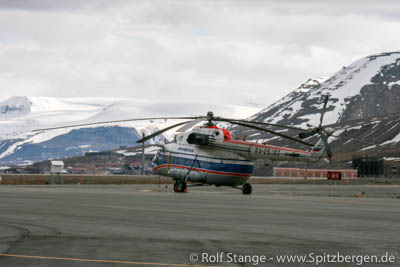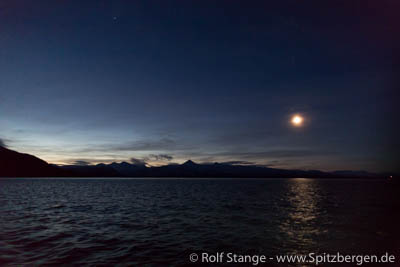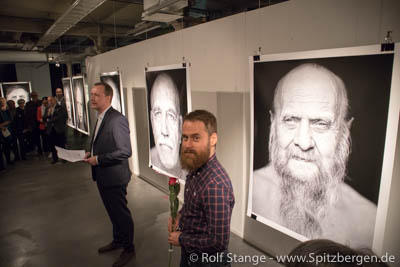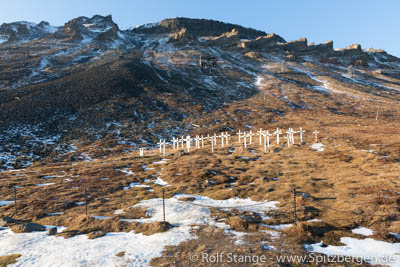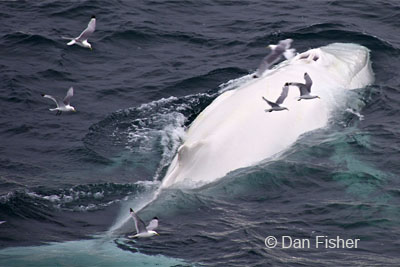-
current
recommendations- Liefdefjord
New page dedicated to one of Spitsbergen's most beautiful fjords. Background information and many photos.
- New Spitsbergen guidebook
The new edition of my Spitsbergen guidebook is out and available now!
- Liefdefjord
New page dedicated to one of Spitsbergen's most beautiful fjords. Background information and many photos.
Page Structure
-
Spitsbergen-News
- Select Month
- May 2025
- April 2025
- March 2025
- February 2025
- January 2025
- December 2024
- November 2024
- October 2024
- September 2024
- August 2024
- July 2024
- June 2024
- May 2024
- April 2024
- March 2024
- February 2024
- January 2024
- December 2023
- November 2023
- October 2023
- September 2023
- August 2023
- July 2023
- June 2023
- May 2023
- April 2023
- March 2023
- February 2023
- January 2023
- December 2022
- November 2022
- October 2022
- September 2022
- August 2022
- July 2022
- June 2022
- May 2022
- April 2022
- March 2022
- February 2022
- January 2022
- December 2021
- November 2021
- October 2021
- September 2021
- August 2021
- July 2021
- June 2021
- May 2021
- April 2021
- March 2021
- February 2021
- January 2021
- December 2020
- November 2020
- October 2020
- September 2020
- August 2020
- July 2020
- June 2020
- May 2020
- April 2020
- March 2020
- February 2020
- January 2020
- December 2019
- November 2019
- October 2019
- September 2019
- August 2019
- July 2019
- June 2019
- May 2019
- April 2019
- March 2019
- February 2019
- January 2019
- December 2018
- November 2018
- October 2018
- September 2018
- August 2018
- July 2018
- June 2018
- May 2018
- April 2018
- March 2018
- February 2018
- January 2018
- December 2017
- November 2017
- October 2017
- September 2017
- August 2017
- July 2017
- June 2017
- May 2017
- April 2017
- March 2017
- February 2017
- January 2017
- December 2016
- November 2016
- October 2016
- September 2016
- August 2016
- July 2016
- June 2016
- May 2016
- April 2016
- March 2016
- February 2016
- January 2016
- December 2015
- November 2015
- October 2015
- September 2015
- August 2015
- July 2015
- June 2015
- May 2015
- April 2015
- March 2015
- February 2015
- January 2015
- December 2014
- November 2014
- October 2014
- September 2014
- August 2014
- July 2014
- June 2014
- May 2014
- April 2014
- March 2014
- February 2014
- January 2014
- December 2013
- November 2013
- October 2013
- September 2013
- August 2013
- July 2013
- June 2013
- May 2013
- April 2013
- March 2013
- February 2013
- January 2013
- December 2012
- November 2012
- October 2012
- September 2012
- August 2012
- July 2012
- June 2012
- May 2012
- April 2012
- March 2012
- February 2012
- January 2012
- December 2011
- November 2011
- October 2011
- September 2011
- August 2011
- May 2011
- April 2011
- March 2011
- February 2011
- January 2011
- December 2010
- November 2010
- September 2010
- August 2010
- July 2010
- June 2010
- May 2010
- April 2010
- March 2010
- February 2010
- November 2009
- October 2009
- August 2009
- July 2009
- June 2009
- May 2009
- April 2009
- March 2009
- February 2009
- January 2009
- December 2008
- November 2008
- October 2008
- August 2008
- July 2008
- June 2008
- May 2008
- April 2008
- March 2008
- February 2008
- April 2000
- Select Month
-
weather information
-
Newsletter

| Guidebook: Spitsbergen-Svalbard |
Home → October, 2017
Monthly Archives: October 2017 − News
Helicopter crash: wreck soon to be lifted
The wreck of the Russian helicopter that crashed into Isfjord last week was identified on photos taken by a dive roboter from the research vessel Ossian Sars. The MI-8 helicopter is lying on the sea floor at a depth of 209 metres in Isfjord, about 2 km from the Russian helicopter base at Heerodden close to Barentsburg.
One body was found in a distance of 130 metres to the wreck. It is already in Longyearbyen. There is no hope that any of the 8 people in the helicopter, 5 crew and 3 scientists, survived.
The Norwegian authority for traffic disasters (Statens havarikommisjon for transport, SHT) is now in charge of further investigations. A salvage vessel is expected to arrive in Longyearbyen on Thursday. The uplifting operations will start as soon as the vessel is in position at the accident site. Russian specialists are in Longyearbyen to support the Norwegian forces under Norwegian leadership. When the wreck is lifted, it will be taken to the Norwegian mainland for further investigations. SHT is currently conducting interviews with witnesses and collecting various data including weather, the condition of the helicopter, qualification of the crew and more.
Photo by a dive roboter of the research vessel Ossian Sars used to identify the wreck (image © G.O. Sars).
Source: SHT
Helicopter crash: wreck found
The wreck of the Russian helicopter that went missing on Thursday afternoon is now most likely found. A ROV (Remotely Operated Vehicle) of the Norwegian Navy has localized an object at a depth of 209 metres on the sea floor that appears to be the wreck of the MI-8 helicopter. The ROV named “Hugin” and another ROV of the research vessel Ossian Sars will continue to gather data to identify the object and to find the missing persons. There were 8 people in the helicopter when it crashed on Thursday. No traces of survivors could be found.
The position is 2.2 kilometres northeast of the Russian helicopter base at Heerodden close to Barentsburg.
A Russian aeroplane has brought divers and other specialists from Russia to Longyearbyen to take part in the operation under Norwegian leadership.
Diving roboter Hugin of the Norwegian navy searching after the crashed helicopter near Heerodden.
Sources: NRK, Svalbardposten
Helicoptercrash: little hope to find survivors
There is no certainty yet if the object that was located by echolot in a depth of 200-250 metres on the sea floor in Isfjord, not far from the Russian helicopter base at Heerodden close to Barentsburg, actually is the wreck of the helicopter. But there is no doubt that the MI-8 helicopter did crash into Isfjord yesterday. As more than 20 hours have gone by since the crash and there is no trace yet of any survivors, hopes to find any of the 8 people on board are getting smaller and smaller and the worst has to be feared.
Names of the 8 persons on board were already yesterday released by Russian media. Now, also the responsible Norwegian authority, the Rescue Centre North Norway, has released the names officially.
The persons on board the helicopter were
Passengers (Scientists of the Instituts for Arctic and Antarctic Research in St. Petersburg):
Oleg Golovanov
Nikolaj Fadejev
Maksim Kaulio
Crew:
Jevgenij Baranov – Chief pilot
Vladimir Frolov – Second pilot
Aleksej Pouljauskas – Mechanic
Marat Mikhtarov – Technician
Aleksej Koroljov – Engineer
There is hope until the opposite is proven, and every effort is taken to continue the search and find survivors. Norwegian SAR forces are on location with helicopters, a special aeroplane from the Norwegian airforce, ships and boats. But the more time is going by, the more likely it seems that it is a tragedy without survivors.
The Sysselmannen has established a contact phone number for relatives and expresses deep sympathy with those who are affected. This is shared by the author of these lines, whose thoughts and sympathy are also with those who were in the helicopter and their family, friends and colleagues and all others who are involved.
According to international law, Norwegian authorities are responsible for the investigation of the accident. A havary commission is already in Longyearbyen and will soon start to gather all information that is available. But currently, the effort to find survivors and the helicopter are still the focus of all efforts.
Russian MI-8 helicopter at the airport Longyearbyen (archive image).
Source: Sysselmannen, Svalbardposten
Crashed helicopter probably found
The Russian helicopter that crashed on Thursday afternoon is probably found. Search-and-rescue forces sensed a strong smell of fuel and saw air bubbles coming to the water surface at a certain position in the area in question, in Isfjord, about 2-3 km from the helicopter base at Heerodden. A ship has found an object on the sea floor with the echolot that could be the wreck of the helicopter or a part of it. This needs to be confirmed, though. The depth is between 200 and 250 metres, far beyond the reach of divers.
Already during the night, a diving robot (ROV = Remotely Operated Vehicle) was brought from mainland Norway to Longyearbyen with a SAS plane. The ROV will be operated at the alleged accident site as soon as possible. This has probably already happened at the time of writing (08.30 local time on Friday morning) or it may be going on right now.
There were 8 persons on board the helicopter, and the search after survivors is going on. SAR forces are searching the nearby coast, east of Heerodden. Helicopters and ships are scanning the water. According to all that is known, the worst has to be feared, but all efforts are taken to find survivors. The Russian helicopter was of the type MI-8, which is equipped with a life raft and with lifting bodies that keep the helicopter afloat at least for a while in case of a controlled emergency landing on the water surface. The fact that no emergency signal was released by the crew makes it however doubtful that it was a controlled emergency landing. A sudden, uncontrolled crash seems likely. Witnesses say they have heard a loud noise like a bang at the time in question.
Next to the 2 Norwegian SAR helicopters, there is a number of ships and boats in the area: Polarsyssel (Sysselmannen), coast guard and boats from the tourism industry in Longyearbyen. Initially, the visibility was reduced by snow fall, but the weather is by now quite good, with little wind and clear visibility. The polar night has begun a couple of days ago, so even around noon, the sun remains below the horizon, making light very scarce.
Light conditions in Isfjord during the polar night around noon. The bright light is the moon. (Archive image.)
Source: Svalbardposten
Russian helicopter crashed near Barentsburg
There will be updates (see bottom end of this article) as further information becomes available.
A Russian MI-8 helicopter crashed near Barentsburg and fell into the sea in Isfjord. The helicopter was on the way from Pyramiden to Barentsburg with 8 persons on board.
The emergency call from the airport tower Longyearbyen was received at 15.35 local time by the emergency response centre North Norway. Norwegian search and rescue (SAR) forces are on location with helicopter and ships. The crash site is in the Isfjord, 2-3 kilometres away from Heerodden, the Russian helicopter base at Barentsburg.
No information is currently available regarding the condition of the 8 persons on board. There is a breeze (7-8 m/s) and the visibility is affected by snowfall.
According to Norwegian law, the Russian helicopters in Spitsbergen are only allowed to fly for company purposes. Charter flights, for example for film teams or scientists, are not permitted. This makes it likely that the 8 people on board were employees of the owner of the helicopter, Trust Arktikugol.
Update: next to the pilot (Baranov Evgeny), co-pilot (Frolov Vladimir), flight engineer (Alexei Poulyauskas), a technician (Mihtar Marat), and an engineer (Korolev Aleksey), there were 3 scientists of the Institute for Arctic and Antarctic Research in St. Petersburg on board: Golovanov Oleg, Fadeev Nicholas, Kaulio Maksim. The names were released in the Russian press.
Update: Dmitrij Zjeljazkov, director of Konvers Avia, the company that owns and operates the helicopter, has told the Russian news agency Tass that the 3 passengers were miners of the Trust Arktikugol.
Russian MI-8 helicopter at the airport Longyearbyen (archive image).
Source: NRK
Spitsbergen-calendar 2018: frozen waterfall in January
In the high arctic, January is icy cold – usually at least. Sometimes, spells of mild air masses from the Atlantic can bring temperatures fluctuating around zero degrees and rain. That was not totally unknown in the first half of the 20th century eithe, but it is certainly more frequent in the times of climate change. But normally, it is really cold! The temperatures will make every river and every waterfall freeze solid.
The January page of the Spitsbergen calendar 2018 shows the waterfall Hyperittfossen in De Geerdalen, about 20 km northeast of Longyearbyen as the ivory gull flies. The watermasses that fall down over basaltic rock cliffs are quite impressive in the summer. Now in the winter, the water is frozen to create structures like organ pipes. I used a rather extreme 11 mm wide angle lense to capture the perspective. It is not every year that the shapes of the frozen waterfall are so impressive: when I took this panorama of Hyperittfossen some years ago, most of the icy structures were hidden under snow.
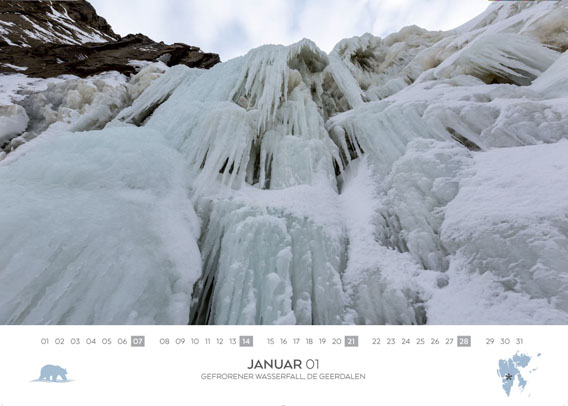
Spitsbergen-Calendar 2018: January. Frozen waterfall.
The Spitsbergen-calender 2018: northern lights over Longyearbyen in December
The northern light is for the polar night what the polar bears are for the summer: everybody wants to see them. The northern light, or Aurora borealis, is indeed a majestic phenomenon! If you have ever seen a real one, you will for sure not forget it. There is an info page about northern lights and northern light photography on this website, by the way. The season is about to begin.
Actually, Longyearbyen is not even the best place to see northern lights. If you are on an Aurora mission, then northern Scandinavia may be just as good, if not better. But of course you can see fantastic northern lights in Spitsbergen! With some luck, you can even see then mid-day. This dayside aurora is comparatively rare, but they do happen. Hard to believe, but true! This requires real darkness 24 hours a day, and that is what you get in Longyearbyen from late November to early January.
The December-photo of our Spitsbergen-calendar 2018 was taken early evening. We went around in Longyearbyen with a TV team and they wanted norhtern lights – of course. Risky business if you don’t have more time than just a very few days! Maybe you are lucky, maybe not … both the weather and the aurora activity have to be on your side. We had already been around for a long evening without seeing more than dark clouds. A day later, things were more promising. And suddenly, the sky exploded over Longyearbyen! It was indeed one of my better Aurora moments in Spitsbergen. The photo does not even show the strongest northern light of that evening, but Lady Aurora was dancing above this part of the iconic coal cableway and Platåberget, a very characteristic and well-known mountain right next to Longyearbyen.
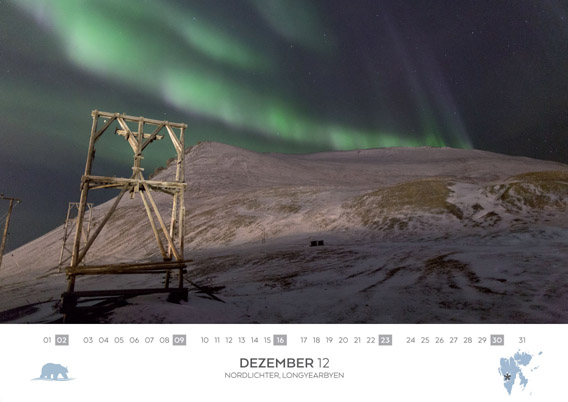
Spitsbergen-Calender 2018: December. Northern light above Longyearbyen.
Born in Sauna: Alexander Lembke’s Sauna exhibition opened in Tampere
Alexander Lembke is well known to many who have travelled with us in recent years in Spitsbergen. Many have heard about his project of science, photography and practical use of the Finnish sauna.
Now, the project has reached a (preliminary) climax: the exhibition “Sauna Syntyneet (Born in Sauna)” was opened on Friday, October 13, in Tampere in Finland. The exhibition was supported by organizations including the Goethe-Institut, the town of Tampere and the Finnish Sauna Society. Their representatives were present at the opening and held speaches.
Alexander’s work is about the important role of sauna in Finnish culture, history and society. The current exhibition is about people who were actually born in a sauna. A sauna is regularly heated and cleaned and it is a place of spirituality, which altogether makes it a place well suited of events such as giving birth. People were born in sauna in Finland also in recent years, also it is much less common than in the more distant past. The exhibition shows large portraits of people who were born in sauna. In poetic films, they tell their stories about their individual relationship to the sauna and their sauna rituals. The youngest person portraited in the exhibition is 5 years old now, the oldest one is 102! Some of these people, who were born in sauna, were present during the opening.
If you happen to come to Tampere until November 24, 2017, then you have got the opportunity to visit the exhibition “Saunassa Syntyneet (Born in Sauna)”.
Alexander Lembke during the opeing of the exhibition “Saunassa Syntyneet (Born in Sauna)” on Friday in Tampere.
Coal mining in Sveagruva is history
The Norwegian government in Oslo has decided that the coal mine in Lunckefjellet near Sveagruva will not come into productive operation. The mine was opened in 2014 but since then, it has only been driven in standby mode.
The mining company Store Norske has suffered badly from low prices on the world markets for coal for years (see for example Store Norske bailout, May 2015). Near 300 employees had to leave, only about 100 are left.
These remaining ones will not be able to enjoy their jobs for many years either, since Norwegian Secretary of State for Trade and Industry Monica Mæland anounced on October 12, 2017, that the government will not support renewed productive mining in Sveagruva, namely Lunckefjellet. Further production without financial support from Oslo is not possible. The government is also the owner of the mining company Store Norske. Neither the government nor Store Norske are interested in keeping the current standby operation upright.
As a result, the next couple of years will see the phaseout of mining activities in Sveagruva and a big general cleanup of the place. This will, at least, keep most of today’s employees in Store Norske busy.
It is also said that the government does not plan major alternative activities in Sveagruva, such as tourism or science. It is, however, not excluded that some buildings may be used for these purposes.
The decision does not affect coal mining in mine 7 near Longyearbyen, which is taking place on a comparatively small scale to supply the local power plant and minor volumes for export.
Soon history: Norwegian coal mining in Svalbard.
Source: NRK
Spitsbergen-calendar 2018: November introduced
The next image from the Spitsbergen calendar 2018 is the month November. It shows a small group of Spitsbergen reindeer. These shed their antlers once every year. The exact time is different for males and females. It also varies individually, to some degree.
This small herd of reindeer shows all variations in their antlers: one does not have antlers at all, one dones only have one half and the third one has got the full set of antlers!
The photo shows reindeer in a winter environment at Diabasodden in Sassenfjord. In the early winter, reindeer have got their fat reserves, next to the meagre vegetation that is mostly hidden under snow. Later, when the fat reserves are used up and the tundra is still under snow and ice, the risk from starvation will increase strongly.
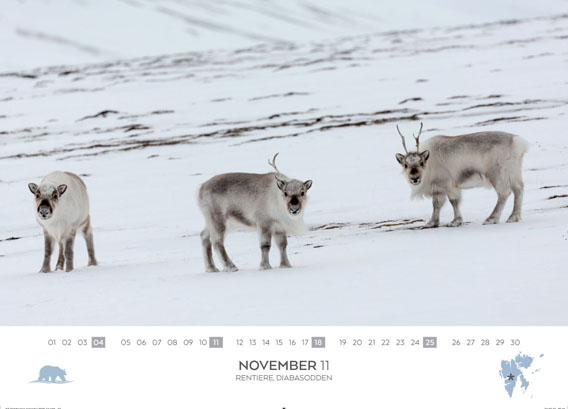
Spitsbergen-Calendar 2018: November. A group of Spitsbergen-reindeer with different variations of their antlers.
Longyearbyen cemetery may be moved because of avalanche risk
The cemetery of Longyearbyen has been in a calm part of the valley Longyeardalen for about a century, between the church and Huset, the old town meeting place. It is still an active cemetery, the last burials were in 2013 and there may be more in the future. Only urn burials are allowed, however.
The location of the cemetery is calm, but maybe not calm enough in the long term. The steep mountain slopes nearby have produced avalanches in recent years, mostly landslips after periods of rain, which have reached the terrain around the cemetery. In the last summer, even the road between the church and Huset was closed for prolonged periods. It is probably only a question of time until the cemetery itself is hit and badly damaged.
This is a scenario which Longyearbyen church with priest Leif Magne Helgesen are not willing to accept. Helgesen has taken initiative and started a debate which may lead to a relocation of the cemetery. It is a place of peace and dignity, for which many people have strong feelings, according to Helgesen. He reasons that it would accordingly be irresponsible to leave the cemetery in a place where it may suffer bad damage.
First meetings with authorities like the Sysselmannen, who is responsible for monument conservation, and the local adminstration have taken place. Authorities in Longyearbyen have experience with moving and securing graves from historical graves that are threatened by coastal erosion. Moving a whole cemetery would, however, be a project of an entirely different scale. Also relatives will have to be involved.
A new location would naturally be near the church, which is a quiet part of Longyearbyen and has areas that are not at risk from avalanches and landslides.
The cemetery in Longyearbyen may be moved due to the risk of landslides and avalanches.
Source: Svalbardposten
Spitsbergen-calendar 2018: the stories behind 2 months
The September-page of our Spitsbergen-calendar 2018 …
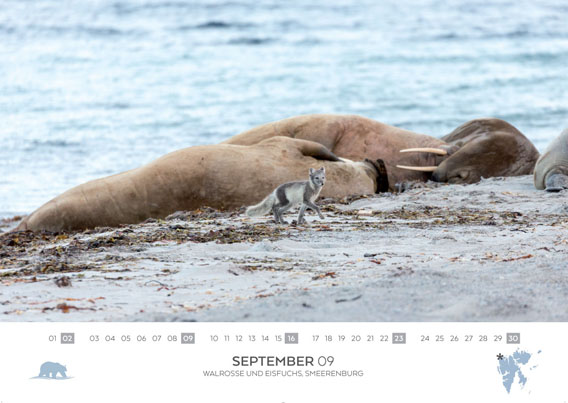
Spitsbergen-Calender 2018: September. Walrusses and polar fox.
… shows a group of walrusses on the beach at Smeerenburg on Amsterdamøya doing what walrusses do best: sleeping and digesting mussels. While we keep a respectful distance of a good 30 m in order not to disturb the walrusses during their nap, a cheeky polar fox which does not care about regulations and distances runs directly next to the walrusses! Who could not care less about the polar fox.
The polar fox left as quickly and unexpectedly as it came, and only this snapshot remains from the memorable encounter.
And the October-page …
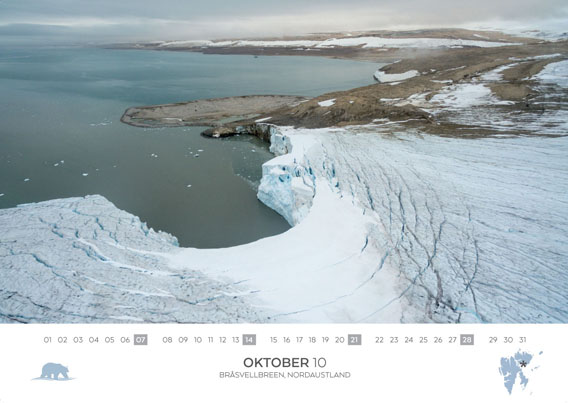
Spitsbergen-Calender 2018: October. Bråsvellbreen, Nordaustland from a bird’s eye view.
… shows Bråsvellbreen. This mighty glacier belongs to the ice cap of Austfonna on Nordaustland. The size is overwhelming, the ice cap has a total area of about 8500 square kilometres! The glacier Bråsvellbreen is only a small part of that. It is well-known for the waterfalls that are cascading down the ice cliff during the melting season. Here, we see it from a bird’s eye perspective!
Click here for more information about the Spitsbergen calendar 2018.
White humpback whale again seen in Svalbard
White humpback whales are a very rare phenomenon. Globally, scientists know of three individuals. Two of them live in Australian waters and a third one in the north Atlantic. The latter one has recently been seen again for the first time in years. First sightings date back to 2004 and 2006, then near the north Norway coast. In August 2012, a white humpback whale was sighted several times east of Spitsbergen. It was most likely the same animal as in 2004 and 2006. No photos are known from those early sightings, but in 2012, a number of amazing shots were taken. Especially noteworthy are those taken by Dan Fisher, mate on the sailing ship Antigua, from the mast of the ship. Due to the high perspective, almost the whole animal can be seen on the photos.
Humpback whales live in all of the world’s oceans. They are usually mostly dark grey to black. The bottom side and parts of the fluke and flippers are partly white. The exact pattern can be used to identify individuals, just like the fingerprint of humans.
Completely white humpback whales are very rare. The unusual colour is usually due to leucism, a partial loss of pigmentation which leads to pale or white colour. Only one of the two white humpback whales in Australia is actually an albino.
Now, there has been a sighting of a white humpback whale in the north Atlantic, the first one since 2012. The whale was seen in late September by scientists on board the research vessel Johan Hjort in eastern Svalbard. This area is often frequented by humpback whales at this time of the year.
White humpback whale in Hinlopen Strait, photographed on August 11 2012 by Dan Fisher.
Source: Havforskningsinstituttet
News-Listing live generated at 2025/May/04 at 03:41:48 Uhr (GMT+1)


